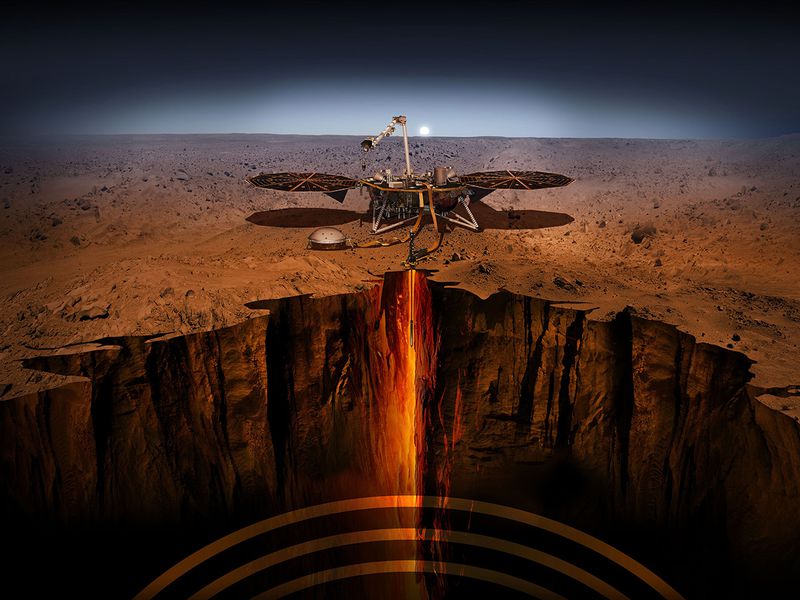
NASA Terminates Martian Rover's Penetration Mission.
Share
NASA has told its $1,069,701,536.23AUD Mars "mole" it will attempt to dig no more.
As such, the heat-seeking droid will never reach its target depth to learn more about the red planet's internal heat signatures. And after repeated issues in penetrating the Martian soil, the NASA InSight heat probe is being forced into retirement from the digging game.
The mole's mission was to dig at least 3 metres into Mars so temperature sensitive equipment can collect data. However, the mole met friction problems when digging not long after landing in February, 2019. The deepest the rover has managed in no more than 3cm.
When its shovel arm attempted to burrow, it would "bounce" back from the sheer hardness of the soil. A NASA statement on the mission cancellation read, "... the soil’s unexpected tendency to clump deprived the spike-like mole of the friction it needs to hammer itself to a sufficient depth."
In a final hurrah, the handler team tried a final time to a scoop on the robotic arm to scrape topsoil into the probe and pack it down in an effort to create more friction. However, 500 attempts in a single day later (with zero progress), the team exhausted every available option.
“We’ve given it everything we’ve got, but Mars and our heroic mole remain incompatible,” said principal investigator, Tilman Spohn.
More than two years later and a lot of tinkering with no results, the handlers at NASA have said enough is enough. As such, the mole will abandon its mission as the first underground mole on Mars.

Image: The “mole,” a heat probe that traveled to Mars aboard NASA’s InSight lander, as it looked after hammering on Jan. 9, 2021, the 754th Martian day, or sol, of the mission. After trying since Feb. 28, 2019, to bury the probe, the mission team called an end to their efforts.
Credits: NASA/JPL-Caltech
“We are so proud of our team who worked hard to get InSight’s mole deeper into the planet. It was amazing to see them troubleshoot from millions of miles away,” said Thomas Zurbuchen, associate administrator for science at the agency’s headquarters in Washington. “This is why we take risks at NASA – we have to push the limits of technology to learn what works and what doesn’t. In that sense, we’ve been successful: We’ve learned a lot that will benefit future missions to Mars and elsewhere, and we thank our German partners from DLR for providing this instrument and for their collaboration.”
The decision was announced a few days after a review board observed the scientific input of the mole rover. The board ultimately found no reason to keep the mole operational as a priority.
However, it will continue working as a scientific apparatus on Mars with deprioritised instruments to save power and extend its batteries past the expected power depletion time of December, 2022.
And yet, it wasn't all for nothing.

NASA personnel learned a lot about the properties of Mars soil thanks to first hand contact via the mole. This allows for better understanding and planning for the soils unique properties where future missions can be better equipped.
The mole had no predecessors and valiantly attacked Mars' harsh surface without any reconnaissance on its opponent. “The mole is a device with no heritage. What we attempted to do – to dig so deep with a device so small – is unprecedented,” said Troy Hudson, a scientist and engineer at NASA’s Jet Propulsion Laboratory in Southern California who has led efforts to get the mole deeper into the Martian crust. “Having had the opportunity to take this all the way to the end is the greatest reward.”
Apart from learning from the toughness of Mars soil, it provided invaluable time for handlers to become better operators of the robotic arm from millions of kilometres away. In fact, the challenges faced by the soil forced handlers to think of innovative ways to use the robotic arm to overcome them.
In the near future, the robotic arm will be used to bury a tether that connects the lander and InSight's seismometer. Although, not very deeply. Even a light layer of topsoil will aid the highly sensitive seismometer in clearly hearing Marsquake data without interference from temperature changes.

Image: The Seismic Explorations for Interior Structure, SEIS, as seen on Jan. 6, 2019. Photo Credit: Photo credit: NASA/JPL-Caltech
While the initial mission was a bust, there's still more to come from InSight and the failed penetrator. NASA recently extended the mission for two more years, to Dec. 2022. Along with hunting for quakes, the lander hosts a radio experiment that is collecting data to reveal whether the planet’s core is liquid or solid. And InSight’s weather sensors are capable of providing some of the most detailed meteorological data ever collected on Mars. Together with weather instruments aboard NASA's Curiosity rover and its new Perseverance rover, which lands on Feb. 18, the three spacecraft will create the first meteorological network on another planet.
InSight's extended mission will not only include quake monitoring, the craft will also collect data via a radio experiment to learn whether the planet's core is solid or liquid. Weather sensors will also help scientists to better understand meteorological conditions on Mars, along with data from NASA's ongoing Curiosity rover mission (which deployed weather instruments in 2012) and the NASA Perseverance rover, set to land on Mars Feb. 18.





